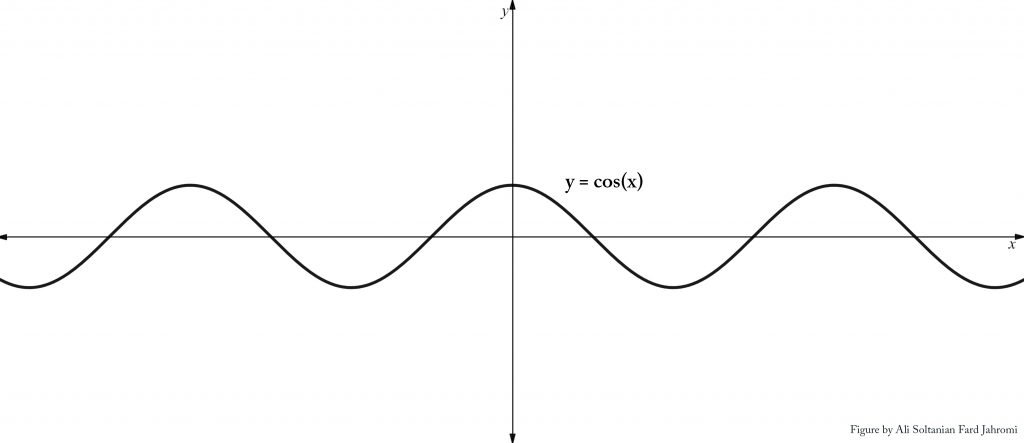
Make Your Dreams Come True GIF 
Make Your Dreams Come True GIF
Link to the GIPHY: https://media.giphy.com/media/Y260fwyrfuoQMWdPMq/giphy.gif
© 2021, Ali Soltanian Fard Jahromi. All rights reserved.


Link to the GIPHY: https://media.giphy.com/media/Y260fwyrfuoQMWdPMq/giphy.gif
© 2021, Ali Soltanian Fard Jahromi. All rights reserved.
By: Ali Soltanian Fard Jahromi
What are the Trigonometric Functions?
The trigonometric functions are a set of functions which show the relation between an angle of a right-angle triangle and the ratio of the lengths of two of its sides. The trigonometric functions are: sine, cosine and tangent. The trigonometric functions are periodic, meaning that their graphs repeat continuously in a specific pattern. For example, here is the cosine function’s graph:

Uses of the Trig Functions in Game Programming
I am a game developer and a digital artist (CGI, 3D animation, digital art). I have developed and released many games in different genres. Trigonometric functions can come particularly useful in game programming. For example, in some games, I have to find a way to implement a day and night system, where the world oscillates between day and night repeatedly as the game progresses. This repetitive pattern can be represented by the cosine trigonometric function. The cosine function always results in a number between negative one and one. In the code for my game, I have a value which represents the brightness of the atmosphere of the environment which can be anywhere from zero to one. To achieve the day and night cycle, I create a variable that is constantly increasing. I then take the cosine of it. Furthermore, I take the absolute value of that variable so that the value of the variable is never below zero. The figure below is a model representing the day and night cycle implemented in the game:

The result is a trigonometric function representing the day and night cycle in my game program.
Developed by: Ali Soltanian Fard Jahromi
Download on Steam: https://store.steampowered.com/app/1639190/Cuboid_Bouncer/
Download on Google Play: https://play.google.com/store/apps/details?id=com.SoltanianGames.CuboidBouncer
Download on Microsoft Store: https://www.microsoft.com/store/productId/9N3ZQLMB2PRR
Cuboid Bouncer is a 3D Side-Scroller video game that includes 12 levels with different challenges on each level. The player is called Cuboid (a cube like character) that must jump or bounce its way through the different obstacles. Each higher level is more challenging and difficult than the previous level. There are power-ups available that can make Cuboid jump higher or move faster. To successfully complete each level the player must successfully go to the end of the level without falling. To finish the game, the player must complete all 12 levels.







Made in 24 hours for the birthday of my sister Fatimah Soltanian Fard Jahromi.
(C) 2021, Ali Soltanian Fard Jahromi. All rights reserved.
Published by: Soltanian Games
By: Ali Soltanian Fard Jahromi
This article was also published on Medium
Culture is the ideas and the way of thinking of a particular group of people.¹ There are many different cultures around the world which vary in many things such as language, rituals and food. Some cultures are related or close to each other in terms of customs and practices and some are very different from each other.
Distinct cultures are different and similar in many things, and when someone comes in contact with a new culture they might experience what is called ‘Culture Shock’. Culture Shock is the feeling of confusion, nervousness or distress when someone comes in contact with a new, unfamiliar culture.² The term ‘culture shock’ was first brought up by Kalervo Oberg (an anthropologist) in 1960. Kalervo Oberg mentioned six negative aspects of culture shock. Strain from psychologically adapting, losing friends, being rejected or rejecting the new culture, confusion in feelings, distress about the ways and rituals of the culture and a feeling of helplessness from not being able to adapt to the new culture.³
Culture shock refers to the distress and nervousness someone feels when they come in contact with a new culture. It can be experienced in many different ways and there are many situations in which someone experiences it. Differences in language, national/cultural holidays, behaviours, customs and clothes can all cause culture shock. A person experiencing culture shock may feel the technology is very different or that some technologies are missing. Take as an example when someone moves to a new country where the language is unfamiliar to them. They then feel they have trouble communicating. This is known as ‘language shock’. It could be the case that a person moving to a new cultural environment doesn’t understand the customs and practices that shape the behaviour of the people in the new culture. This is called ‘role shock’. Another sub-category of culture shock is ‘transition shock’ which is when someone can’t adjust to the new culture.
Language shock, role shock and transition shock can all lead to a person moving to a new culture becoming exhausted in their attempt to adjust. This phenomenon has been referred to as ‘culture fatigue’.⁴ One symptom of culture fatigue is exhaustion from lack of sleep due to the pressure of having to deal with different aspects of culture shock.⁵
A person can also experience culture shock when someone is uprooted from their home or a familiar place.⁶ This experience of culture shock can occur even within a society which is multicultural. For example, if a child is removed from their family and placed with a family that is of a different ethnic and/or cultural group.
When moving to a different cultural environment many might think of the new culture’s customs and practices as being strange.⁷ Some might even feel that the customs and practices of the new culture opposes their ethical, moral and religious world view.
One common group that experience culture shock are students travelling to another country to study. Migrant workers going to other countries for work may also experience culture shock. People escaping war and violence by moving to another country might experience culture shock if the country they move to is culturally different.
A number of symptoms have been identified for those who experience culture shock. Symptoms include, homesickness, boredom, thinking the worst will happen and feeling helplessness.⁸
A Canadian anthropologist by the name of Kalervo Oberg identified five stages of Culture Shock. Oberg described culture shock through a ‘u-curve’ of stages. This is known as the U-curve hypothesis. The first stage, also known as ‘the honeymoon stage’ is the very first contact with the new culture. At this time the person is awestruck at what he/she is seeing and going through. This is where the person is amazed they come in to contact with new architecture, different flavoured food and an interesting community. Everything feels different and interesting. The second stage, the crisis stage, is when the person who moved to the new culture starts feeling confused and stressed. The person’s unfamiliarity with the new culture means they don’t know how to behave and fit in as part of the new community. Not knowing how to behave and communicate within the new culture can be frustrating and confusing. They don’t know how to talk with people in the customary way common to the new culture or might be completely unfamiliar with the new culture’s language. This causes them to become stressed and feel isolated. The third stage, or the recovery stage, is where this confusion and distress decreases. They start learning new things, knowing more people and learning about the language and customs of the new culture. This leads to the fourth stage, the adjustment stage, which is when the person has completely adapted to the new culture.⁹
Some individuals might return to their native culture after being away for a long period of time. This is where some people are affected by what has been referred to as ‘Reverse Culture Shock’ also known as ‘re-entry shock’. This is the fifth and final stage of culture shock. Reverse culture shock is when someone feels distress and confusion when returning back to their own culture. For example, when someone who has travelled to another culture comes back to their own culture, they might feel as if it isn’t the same as it was before they left, and as a result they once again experience distress and confusion.¹⁰ The person’s friends and family might have moved or left their homes. Their neighbourhood could have changed significantly in a way that environments where they had developed fond memories are no longer in existence. The familiar buildings have disappeared, the houses have been destroyed and rebuilt and everything familiar to him/her has completely changed. They might have adjusted their customs and behaviours in accordance with the culture they had moved to and are no longer comfortable with their native cultural ideas and practices. For example, a person might have experienced freedoms that was not available to them in their native culture and are therefore uncomfortable with the restrictions placed on them when they move back.
Reverse culture shock again can be described as following a u-curve of adapting to what is now a new environment or even what seems to be a new culture.¹¹ Reverse Culture Shock also goes through the steps of Culture Shock. It goes through the honeymoon, crisis, recovery and adjustment stages.
Many people experience culture shock, but some are more prone to it than others. The cause of this could be that different people have different personalities and so some are more prone to it than others. Being more prone to culture shock can depend on many things. For example, how prone someone is to culture shock depends on the person’s attitude towards others or their general worldview. Familiarity with the new culture can also affect how the person deals with culture shock. Some might endeavour to learn about the new culture they are moving or travelling to so that they can function better in it and as a result be less prone to culture shock. Others that are less prepared could be more severely affected by culture shock.
The amount of culture shock experienced can depend on how different the new culture is from the person’s native culture. It can also depend on how long someone has spent time in their native culture. Older people who have spent a long period of time in a particular culture and the customs and behaviours of that culture is ingrained into their life might experience more culture shock than younger people.¹² Communication and interaction with the people of the new culture can also be a catalyst in either reducing or increasing the effect of culture shock. The attitude of the people in the new culture can either facilitate the integration of a person or isolate them.
Students travelling around the world for study regularly experience culture shock. The class they are in, might be strange to them. They might not know how to behave in the class. Their class-mates might not seem friendly to the new students.¹³ This leads to stress and confusion on how to react.
There are hundreds of different cultures around the world. For some, culture shock can be difficult and frustrating while others might not experience it at all or experience it less intensely. The amount of distress experienced over entering a new unfamiliar culture varies from person to person. However, there are ways that culture shock can be reduced. Learning the new culture’s language through language classes or research can assist in communicating with people in the new culture. Making sure to make friends in the new community assists in getting integrated into the new community.¹⁴ Knowing things about the new culture before entering it can also reduce the amount of role shock.¹⁵
Coming back home and experiencing reverse culture shock is also very frustrating. Again, you can deal with this by getting to know the new people and the way things have changed. In my opinion, communication is the key part of stopping culture shock. Culture Shock is a global crisis in modern times which has led to tension in some communities. It affects many people, but improving upon communication is the key to integration and reducing culture shock.
[1] Duncombe, Stephen, Cultural Resistance Reader, New York: Verso, 2002, p.36.
[2] Elmer, Duane, Cross-Cultural Connections: Stepping Out and Fitting In Around the World, Downer’s Grove: InterVarsity Press, 2002, p.44; Dorjee, Tenzin, Communicating Across Cultures, London & New York: The Guilford Press, 2019, p.74.
[3] Pedersen, Paul, The Five Stages of Culture Shock: Critical Incidents around the World, London: Greenwood Press, 1995, p.1.
[4] Reisinger, Yvette, International Tourism: Culture and Behaviour, London, Paris, Amsterdam: Elsevier Inc., 2009, p.215.
[5] Dutton, Edward, Culture Shock and Multiculturalism: Reclaiming a Useful Model From the Religious Realm, Newcastle upon Tyne: Cambridge Scholars Publishing, 2012, p.101.
[6] Cristina, Iqoa, The Inner World of the Immigrant Child, New Jersey: Lawrence Erlbaum Associates Publishers, 1995, p.39.
[7] Pedersen, Paul, The Five Stages of Cultures Shock: Critical Incidents Around the World, London: Greenwood Press, 1995, p.9.
[8] Ferraro, Gary, The Cultural Dimension of Global Business, London: Routledge, 2016, p.200.
[9] Nemeroff, Charles, The Concise Corsini Encyclopedia of Psychology and Behavioral Science, New York: John Wiley and Son’s Inc, 2004, p.251; Parrilo, Vincent, Encyclopedia of Social Problems, London: Sage Publications, 2008, v.1, p.201.
[10] Storti, Craig, The Art of Coming Home, England: Hachette UK, 2011.
[11] Furnham, Adrian, The Psychology of Behaviour at Work: The Individual in the Organization, New York: Psychology Press Taylor and Francis Group, 2005, p.712.
[12] Ward, Colleen, The Psychology of Culture Shock, Philadelphia: Routledge, 2001, p.267; Loosemore, Martin, Essentials of Construction Project Management, Sydney: University of New South Wales Press, 2004, p.82.
[13] Pedersen, Paul, The Five Stages of Culture Shock: Critical Incidents around the World, London: Greenwood Press, 1995, p.263.
[14] Loue, Sana, Encyclopedia of Immigrant Health, Cleveland: Department of Epidemiology and Biostatistics, 2012.
[15] Rader, Debra, New Kid In School: Using Literature to help Children In Transition, New York: Teacher’s College Press, 2003, p.46.
Trailer:
Space Survival – 3D Shoot’em Up Video Game
Developer: Ali Soltanian Fard Jahromi
Publisher: Soltanian Games
The milky way galaxy has become a warzone. A space empire called “The Sheyertonian Empire” has been stealing resources from The Valeratonac Empire. The Sheyertonians will take as much resources from the Valeratonac at any cost. Even if that cost is the lives of many. You are part of the Valeratonac. Your mission is to find and take down their most powerful ships so their main bases can be taken down.
Play for free on Steam: https://store.steampowered.com/app/1559850/Space_Survival/